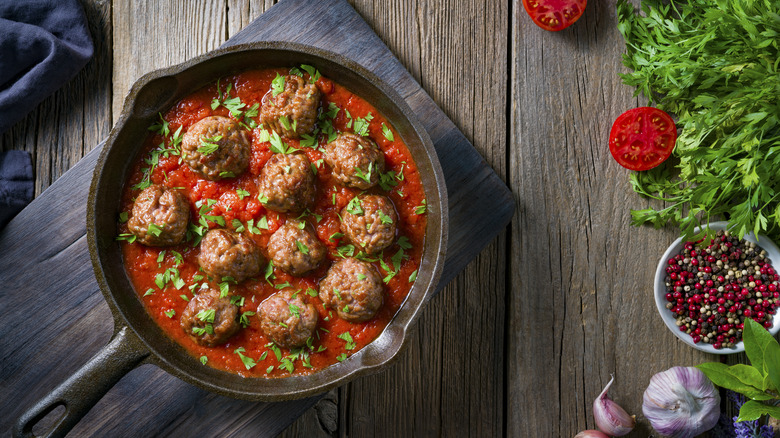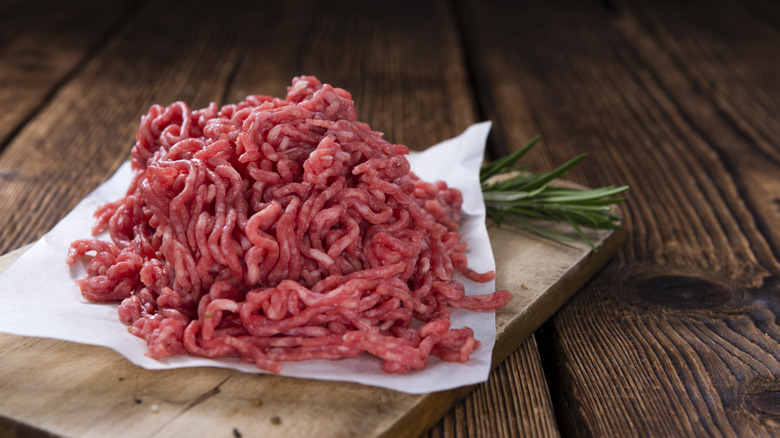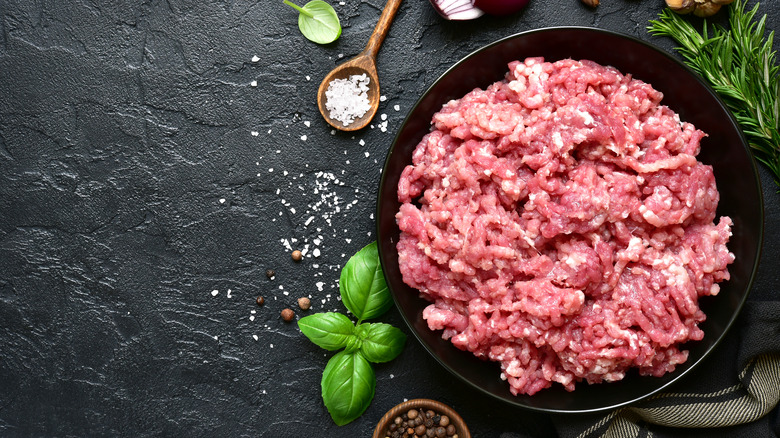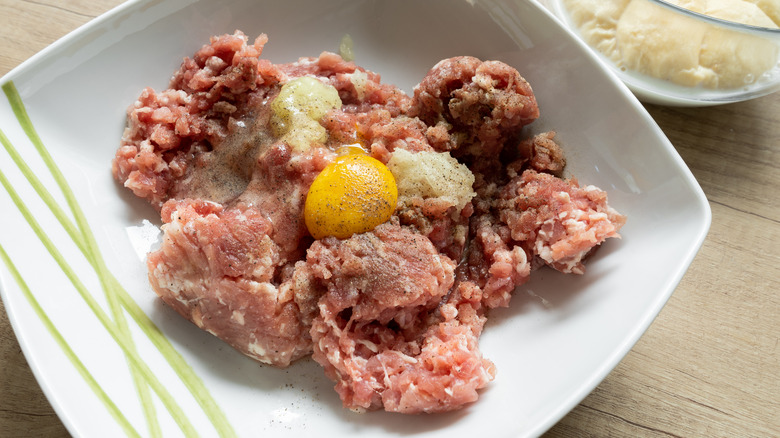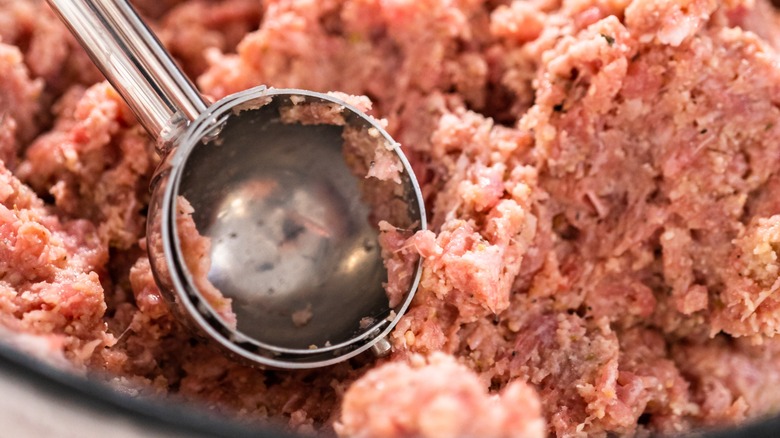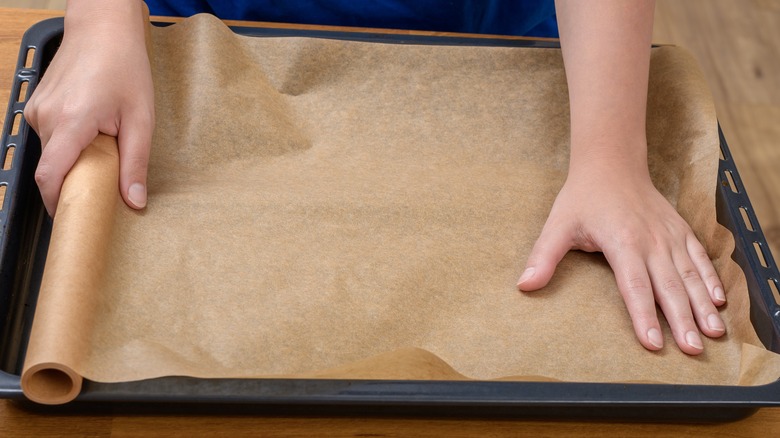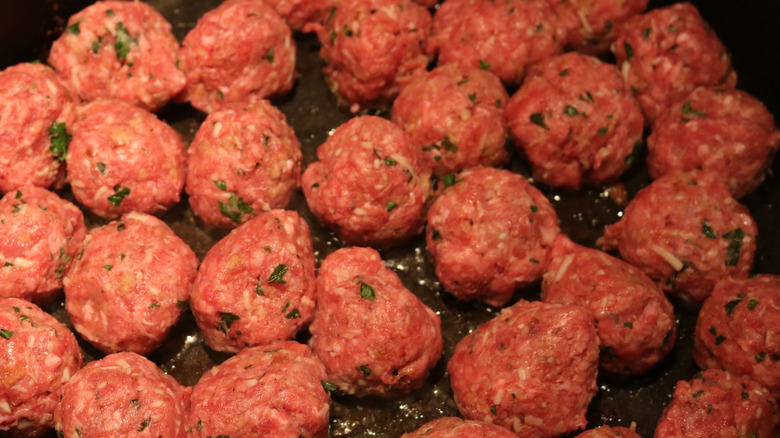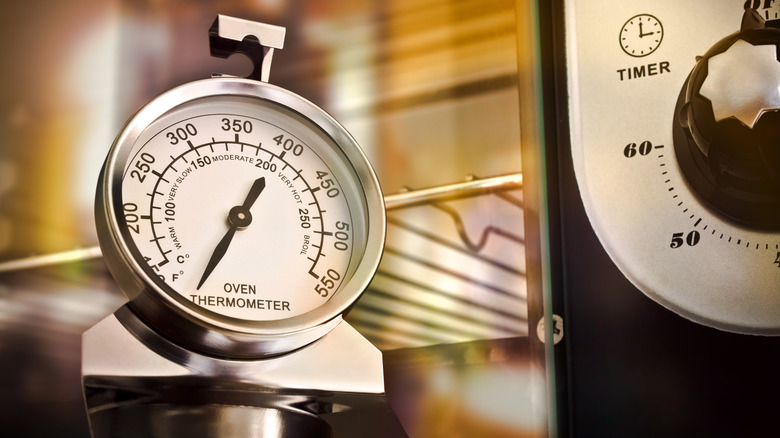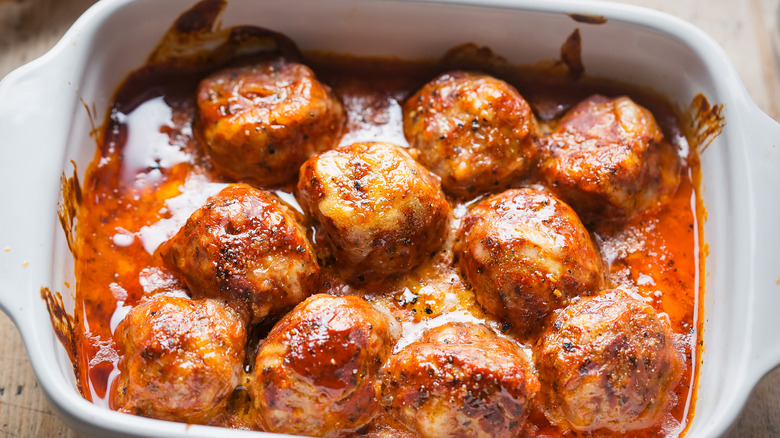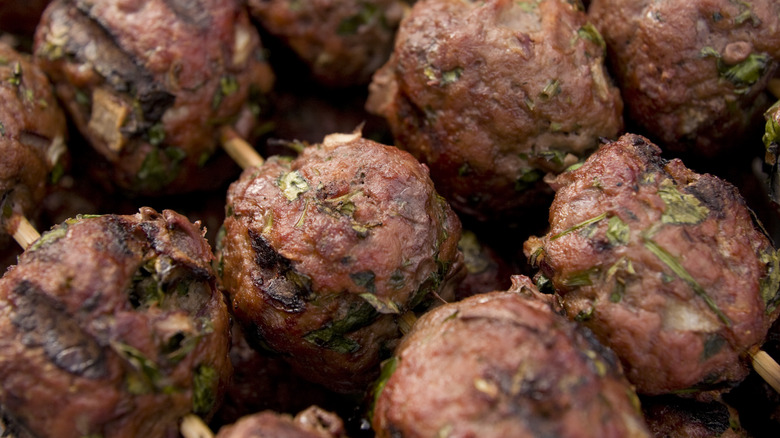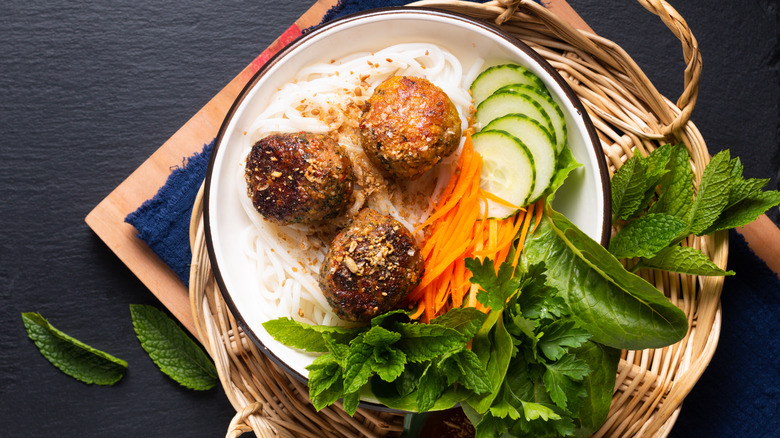Tips You Need When Cooking Meatballs
From Italy to Sweden, Lebanon to Vietnam, meatballs can be found in countless cuisines around the world. Their versatility makes them perfect for all sorts of dishes, but for the most part, the knowledge required to make perfect meatballs remains the same.
Made properly, meatballs have deep, rich flavors that complement sauces, soups, and stews. They are juicy and succulent and often have a tasty, deep brown crust that offers a delightful contrast as you bite down into the tender center. However, there are a few common mistakes people make that result in meatballs that are tasteless, too dry or chewy, or fall apart as they cook because they have failed to hold their shape. Below, we are going to cover some simple but extremely effective tips that should help you avoid ending up with subpar meatballs, no matter what tasty dish you are creating for them to go in.
Choose your meat carefully
Whichever style of meatballs you're planning to make, it's crucial to start with high-quality meat, especially considering it's the primary ingredient. However, the two most important things to consider are your meat's fat content and its flavor.
Ground beef is the classic choice for meatballs, as it strikes a great balance between fat and flavor, but minced beef chuck is worth spending a few extra dollars on. Its higher fat content means your meatballs will help your meatball mix stick together, reducing the need for additional binding ingredients. The fattier meat will also lead to juicier meatballs; although there is a point at which too much fat can make them greasy — it's best to aim for a total fat content of around 20%.
Ground pork is another common pick and it's frequently mixed with other meats to introduce extra moisture, and it adds more complex flavors thanks to its slightly sweet taste. Minced pork shoulder is even fattier and can give you even more succulent meatballs, especially if you're using a leaner beef mince which might struggle to hold its form during cooking.
Veal is another popular ingredient for meatballs, despite not having a particularly intense flavor, as its tender, delicate characteristics make it ideal for recipes where you want your seasoning to do the heavy lifting. Otherwise, it's best to combine it with beef, pork, or both to add depth to your dish.
Proper preparation is key
Being sufficiently prepped is important no matter what you're cooking, but with meatballs, there are a few specific things you'll want to bear in mind. First, make sure you have all of your required ingredients and utensils close to hand.
If you're making meatballs, you're going to be getting your hands dirty when you combine your ingredients, and they'll end up coated in grease and seasonings. If you keep having to dig things out of the fridge or kitchen cabinet, you'll spend half your prep time thoroughly washing your hands, so it makes sense to get everything out and ready before you start.
Additionally, unless you've just come back from the supermarket or butcher, you've probably been keeping your meat in the fridge. Now, we're not picky enough to suggest you only use freshly bought meat for meatballs as that's both unreasonable and unnecessary, but it is important to let refrigerated ingredients reach room temperature before you mix them together. Not only will it make it easier to combine your meatball mix and evenly distribute the ingredients, but it'll also guarantee even cooking. If your meatballs aren't a consistent temperature throughout while raw, they won't be a consistent temperature when they're done, and getting them to a safe heat then risks overcooking and drying them out. For similar reasons, if you're using an oven or pan to cook your meatballs, you should always remember to preheat them to the correct temperature before you start cooking.
Season until your heart's content
Whether you want to enhance the flavors of your chosen meat or let other ingredients take the lead, proper seasoning is crucial if you're after truly tasty meatballs. The good news is that it's also pretty hard to overseason meatballs.
At minimum, you're going to want to be generous with the salt and pepper as these are your basic flavor enhancers. The next best additions are garlic and onion, as these will add depth to the flavor of your meatballs and contribute to their umami profile. If you're after a milder taste, powders are fine, but using fresh, diced garlic and onion will result in a richer dish, and using real onions will add a sweeter dimension that's perfect for balancing the salty and savory elements of your mixture. Plus, there are few cuisines that don't use these two vegetables, so there's little risk of their flavors clashing with any accompanying ingredients or sauces.
Depending on the type of meatballs you're making, you'll also want to get some herbs in the mix. Typically, basil and oregano are perfect for Italian-style meatballs, but rosemary and thyme will increase the savoriness and introduce slightly earthy characteristics. Grated hard cheeses like pecorino or parmesan are another excellent addition, as they'll add a little tang while also helping your meatballs keep their form as they cook. If you're experimenting with a new recipe, you can always season incrementally and test your meat mixture before you start cooking.
Don't forget your binding ingredients
One of the most common issues people experience when making meatballs is getting their mixture to hold together throughout the cooking process. If you're using fattier meats, you'll find they tend to keep their form far better than leaner meats, but you'll often need to add a few extra ingredients to your meatballs falling apart.
Fortunately, there are plenty of binding ingredients to choose from, so while you can pick ingredients that alter the texture and flavor, there are also more neutral-tasting options that will bind your mixture without impacting the taste. Eggs are one of the most popular picks for binding, as the proteins coagulate to hold everything together while they also add moisture without affecting the flavor too much. Most people also add breadcrumbs, which absorb moisture and retain it while the meatballs cook, improving the texture and balancing their tenderness and structure. If you're after a slightly crispier meatball, panko breadcrumbs are the perfect choice.
We've already mentioned using cheese to help your meatballs keep their shape, but a little bit of milk, yogurt, or even sour cream will also do the trick, adding a sharp, creamy flavor while stopping them from drying out as they cook. If you don't want to mess with the taste, cooked rice is a great option, or you can try blended oats to add a deliciously nutty element to your mix.
Size and consistency are crucial
One of the best things about meatballs is that you have free reign over how big or small you want to make them. Smaller meatballs can make the perfect snacks or starters, while bigger meatballs work well with main courses.
However, the type of dish you're making will also dictate the optimum size for your meatballs. For example, if you're planning on cooking your meatballs in a stew or sauce, smaller meatballs are better as they'll take less time to cook and are less likely to fall apart. Conversely, if you're making big meatballs, baking them in the oven is going to ensure they're cooked thoroughly all the way through.
Once you know what size you want your meatballs, you're going to want to make sure they're all the same, otherwise, you risk over or undercooking some of them regardless of your recipe. If you're forming your meatballs by hand, it's not too difficult to make them the same size, but it helps if you can calculate how many you're going to make in advance based on how much mixture you have to work with. If you find yourself struggling to make your meatballs the same size as each other by hand, a useful trick is to use the same technique for making cookies. Grab yourself an ice cream scoop and use it to portion out each ball, and you can guarantee each one is the same size and shape.
Pick the right tools for the job
While making meatballs doesn't necessarily require any specialist culinary equipment, you'll find the whole cooking process far easier with the right tools on hand. First up is picking the right mixing bowl.
The most important thing to bear in mind when choosing your mixing bowl is to go for one that's bigger than you think you might need. Combining meatball ingredients can be a messy business, and there's nothing worse than realizing your bowl is too small as its contents overspill while you're trying to mix everything together.
The next thing to consider is the size of your baking tin or frying pan. If your baking tin is too small, there's a chance your meatballs will stick to each other as they cook in the oven, and you'll find yourself trying to separate them and potentially making them fall apart. A frying pan that's too small poses the same risk, or you might find yourself having to make your meatballs in batches, where the first ones start to cool before the rest are ready. When choosing a baking tin, a glass dish might be preferable as there's less chance of your meatballs sticking to the base and over-browning on the bottom. If you've only got a metal tin to hand, be sure to line it with greased baking paper or foil. Not only will this prevent sticking, but it'll also make cleaning up after much easier.
Sear your meatballs for the perfect crust
In many ways, cooking the perfect meatballs is like cooking the perfect steak, especially when it comes to searing the meat first. The best way to do this is by heating oil in a hot pan and turning your meatballs in it until they have a consistent crown crust all over.
Searing meatballs is important for a few reasons. First, we want to take advantage of the Maillard reaction, which is the chemical process responsible for creating the delicious flavors we associate with roasted and toasted ingredients. The reaction occurs between sugars and amino acids present in the meat when they're heated at high temperatures, and it's what will give your meatballs a delectable crust. It also boosts the savory flavors of the meat, adding more depth to the overall eating experience.
While the idea that searing meat "locks in the juices," is a bit of a misconception, it's true that the caramelized surface helps with moisture retention and will prevent your meatballs from drying out while they cook. Ultimately, searing will result in juicier meatballs with an excellent contrast of crispy and tender textures, reduce the risk of them falling apart during cooking, help your seasonings adhere to the surface of the meat, and boost their overall visual appeal.
Know your cooking times and temperatures
Knowing the best temperature for cooking meatballs and how long to cook them for is crucial if you're aiming for perfection. These factors will vary depending on the size of your meatballs and your ingredients.
The longer you cook meat, the more moisture is lost, so cooking meatballs for too long or at an excessive heat will dry them out. The amount of moisture lost will also depend on the meat's fat content, so leaner meats like chicken or turkey will dry out quicker than fattier beef or pork. Generally, beef or pork meatballs will take around 20 to 25 minutes in the oven at 400 F, but you might find yourself needing to adjust these.
You want your meatballs to be nicely browned on the outside but this doesn't necessarily mean they're cooked all the way through, especially if you've seared them in advance. The safest way to check for doneness is with a meat thermometer, making sure the internal temperature of each meatball is at least 160 F, as it saves having to cut one open to check it's cooked inside.
Manage moisture for the best texture
We've mentioned moisture a few times already but it's hard to understate how much of an impact it has on the texture of meatballs. Too little, and your meatballs will turn out dry, tough, and chewy; too much, and they'll become mushy or greasy.
The natural juices in the meatballs are also going to add a lot of flavors, so if you're concerned your mix is looking too dry or you're using leaner meats, there are a few ways you can increase the moisture content. A splash of milk or even broth can help boost the moisture content of your meatball mix, or you can use egg, which will also work as a binding agent. Another great option is adding diced or grated vegetables into your mix, which will also bring more flavor while boosting the nutritional value of your meal.
There are plenty of suitable vegetables to pick from, and you can't go wrong with the likes of celery, peppers, mushrooms, or carrots, using fresh garlic and onion is more effective than powdered seasonings. However, until they start cooking, these ingredients might make it harder for your meatballs to keep their shape, but searing them first should resolve that particular issue. It's also a good idea to let your meatballs rest a little before serving because, like steak, it allows time for the internal juices to redistribute.
Try out different cooking techniques
Searing and then baking is probably the most common way to cook meatballs, but there are plenty of other methods that can yield equally delicious results. For smaller meatballs, you can often skip the oven and simply saute them with oil in your frying pan, as it's quicker than baking and you shouldn't struggle to get them cooked evenly throughout. However, you will need to keep an eye on the pan, turning the meatballs regularly to avoid over-browning them. For soups and stews, you can boil your meatballs in your broth or sauce, and while you might not get an extra crispy crust, the balls will absorb the flavors of the liquid and become beautifully tender. You can slow-cook meatballs this way too, but it's much easier to dry the meatballs, so monitoring moisture levels is even more important with this method.
If you prefer smoky, charred flavors, you can grill meatballs easily enough, and you'll likely get the best results cooking them on skewers, kebab-style. Steaming is also an option, and it's especially common with Chinese-style meatballs. You'll lack the toasty brown crust, and steaming results in a milder flavor, so it's important to make sure to use powerful seasonings and sauces to compensate.
Don't be afraid to experiment with ingredients and flavors
As we mentioned at the start of this piece, meatballs feature in many, many different cuisines, and you're doing yourself a disservice by not experimenting with different styles. There are too many to list here, but we'll cover a few of the most popular variants to spark some inspiration.
Most people are probably familiar with Italian-style meatballs, which you can tweak by playing around with different seasonings and meat combinations, and if you're feeling adventurous, you can even fill the centers of your balls with gooey cheese, like mozzarella. Swedish meatballs are often boiled and use cream for a softer texture, but they also make use of spices like nutmeg which give them their distinct flavor.
Asian meatballs are another style that should never be overlooked. Frequently steamed, they often include ingredients like soy sauce to add saltiness and umami, and ginger and chili to increase the heat. Thai-style meatballs tend to have an even more intense flavor, using fish sauce for depth, and fragrant ingredients like lemongrass, Thai basil, and kaffir lime leaves. You've also got Mediterranean and Middle Eastern meatballs, which frequently use lamb as part of their meat mix, and take on a curry-like profile thanks to spices and herbs like cumin, cilantro, and fresh mint. Once you've spent some time mastering a few of these styles, you're then free to experiment further, using what you've learned to fuse flavors and create delectable, unique meatballs.

